Inspection
Rugs that come to us for repair are thoroughly inspected to identify the damage, the cause of that damage, and the various options available to correct or minimize that damage. Our goal is not only to make the rug “look” better cosmetically, but also to make certain that the structure of the repaired area is strong enough to allow you to use and enjoy your rug without worrying about further damage.
Rugs are woven to last decades at the least, and centuries at the most, and rugs of all ages travel through our doors. Our specialty is antique and semi-antique rug care, and our knowledge regarding these textiles allows us to give you the information necessary in making the right rug care decisions. If a rug gets to the point that it is “past its prime,” we will let you know what type of floor, type of underlay and level of traffic would be best to help the piece last longer.
Fringe & End Repair:
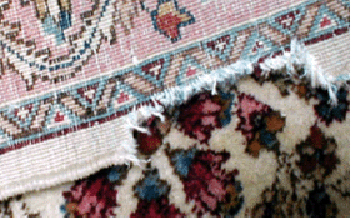
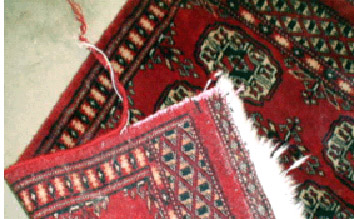
The fringe is the “skeleton” of your rug. Most rugs have white cotton fringe tassels, and others have wool or silk tussles. Some rug owners like the look of the fringe on their rugs, to others it drives them nuts to always be straightening them or keeping them from getting caught in the vacuum cleaner (that’s why you vacuum from side to side instead of from end to end).
But, the fringe is not just a “pretty” way to finish the rug – it is actually the foundation fibres of the rug. The rug’s “skeleton.” Each individual tassel that you grab in your hand runs through the middle of the rug all the way to the other end, emerging as another individual tassel on the opposite end.
WARP: Each individual foundation strand that runs the length of a rug. These strands end up being the fringe tussles of the rug.
WEFT: Each individual foundation strand that runs the width of a rug. We remember these as being the strands that run “weft” to “right.”
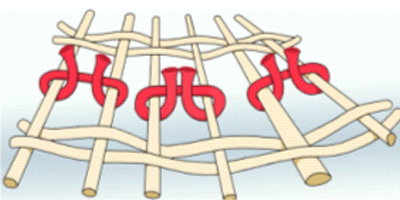
Because the tussles are the warps of a hand-woven rug, a torn or worn fringe is damage to pay particular attention to. This damage can easily result in your rug unraveling and losing its knots (this is where the labour – and value – of a rug is).
Overcast (Securing) Stitch:
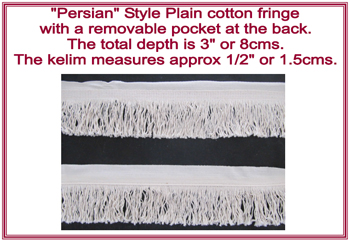
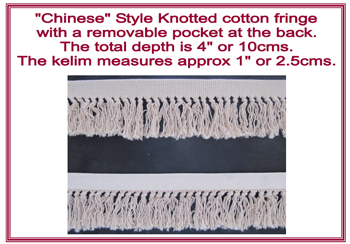
A proper overcast stitch (by hand) along the end of a rug will anchor the knots in place so that they will not “slide” off of the warps. This is a simple looking stitch (either a buttonhole or cross-stitch variety), but knowledge about how to properly anchor the stitch to a weft thread is key. A poorly executed stitch will lead to a tension inconsistency that can result in additional knots unraveling from the rug.
A minimum of an inch of original fringe (exposed warps) tassels is needed for a correct overcast stitch, and it is ideal to have one consistent row of knots to anchor together from left to right – this usually means that the rug must be evened out beforehand to prepare it for the overcast stitch.
Fringe Replacement:
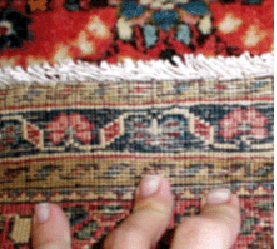
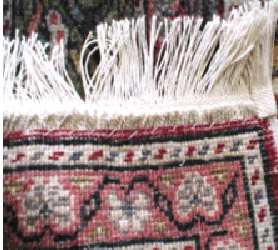
The fringe is the first thing to go on a rug. Years of footsteps on individual tassels cause abrasion. Vacuum cleaners cause damage and they both contribute to tearing, fraying, and an eventual wearing down of the tassels. It’s a noticeable thing to fix, and it is the most common repair that comes through our doors.
First, the end must be secured with an overcast stitch so that the structure of the rug is sound. Then a new prefabricated fringe can be laid along the top of the original fringe base, and attached by hand. Because the fringe is laid on top of the original fringe base (the original tassels are trimmed shorter so that they do not “peek” through the new tassels) it protects the end of the rug from further foot traffic abrasion.
Side Repair:
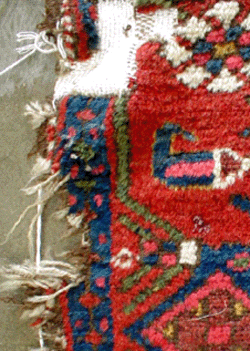
Just as tied-off fringe tassels hold the knots in place from the ends; the side cords hold the knots in place from the sides. The weft (left to right) threads are wrapped around a thick side cord that runs the entire length of the rug (with the warps). This cord holds the rows in place and is usually (after the weaving is completed) wrapped in wool, cotton, goat hair, or silk. The over-wrapping is usually done in a colour that blends well with the overall look of the rug.
Sometimes multiple rugs are woven on the same large loom for higher production numbers. When this is done, the rug wefts are shared between the rugs. To separate the rugs, the shared wefts need to be cut. This means that these wefts are not wrapped securely around a side cord. In fact, what is often done is a side cord is already over-wrapped in a matching colour and they baste it to each side of the finished rug without securing the “loose” weft threads. This makes the rug “look” right, but over time it could start coming away.
Final Note:
These are the most common of the many types of rug repair we offer Torontonians. There are many more, but we hope you have found the above to be informative.
If you have a damaged rug, contact our office at 416-461-4006 to discuss the type of repair that would be best to preserve your valuable rug.
